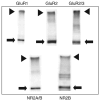Behavioral sensitization to amphetamine is not accompanied by changes in glutamate receptor surface expression in the rat nucleus accumbens
- PMID: 19183251
- PMCID: PMC2723058
- DOI: 10.1111/j.1471-4159.2009.05911.x
Behavioral sensitization to amphetamine is not accompanied by changes in glutamate receptor surface expression in the rat nucleus accumbens
Abstract
We examined whether behavioral sensitization to amphetamine is associated with redistribution of glutamate receptors (GluR) in the rat nucleus accumbens (NAc) or dorsolateral striatum (DLSTR). Following repeated amphetamine treatment and 21 days of withdrawal, surface and intracellular levels of alpha-amino-3-hydroxy-5-methylisoxazole-4-propionate (AMPA) or NMDA receptor subunits were determined using a protein cross-linking assay. In contrast to our previous results in cocaine-sensitized rats, we did not observe redistribution of GluR1 or GluR2 to the cell surface in the NAc after amphetamine withdrawal, although a small increase in total GluR1 was found in the shell subregion. Nor did we observe activation of signaling pathways associated with cocaine-induced AMPA receptor trafficking or changes in NMDA receptor subunits. No significant changes were observed in the DLSTR. We also investigated the effect of administering a challenge injection of amphetamine to amphetamine-sensitized rats 24 h prior to biochemical analysis based on prior studies showing that cocaine challenge decreases AMPA receptor surface expression in the NAc of cocaine-sensitized rats. GluR1 and GluR2 were not significantly altered in either NAc or DLSTR, although a modest effect on GluR3 cannot be ruled out. Our results suggest that glutamate transmission in the NAc is dramatically different in rats sensitized to amphetamine versus cocaine.
Figures





Similar articles
-
Behavioral sensitization to cocaine is associated with increased glutamate receptor trafficking to the postsynaptic density after extended withdrawal period.Neuroscience. 2009 Mar 3;159(1):414-26. doi: 10.1016/j.neuroscience.2008.10.027. Epub 2008 Nov 1. Neuroscience. 2009. PMID: 19105975
-
Cell surface AMPA receptors in the rat nucleus accumbens increase during cocaine withdrawal but internalize after cocaine challenge in association with altered activation of mitogen-activated protein kinases.J Neurosci. 2007 Sep 26;27(39):10621-35. doi: 10.1523/JNEUROSCI.2163-07.2007. J Neurosci. 2007. PMID: 17898233 Free PMC article.
-
Behavioral sensitization to cocaine is associated with increased AMPA receptor surface expression in the nucleus accumbens.J Neurosci. 2005 Oct 5;25(40):9144-51. doi: 10.1523/JNEUROSCI.2252-05.2005. J Neurosci. 2005. PMID: 16207873 Free PMC article.
-
Repeated amphetamine administration alters the expression of mRNA for AMPA receptor subunits in rat nucleus accumbens and prefrontal cortex.Synapse. 1997 Jul;26(3):269-80. doi: 10.1002/(SICI)1098-2396(199707)26:3<269::AID-SYN8>3.0.CO;2-5. Synapse. 1997. PMID: 9183816
-
Extinction training regulates neuroadaptive responses to withdrawal from chronic cocaine self-administration.Learn Mem. 2004 Sep-Oct;11(5):648-57. doi: 10.1101/lm.81404. Learn Mem. 2004. PMID: 15466321 Free PMC article. Review.
Cited by
-
Calcium-permeable AMPA receptors in the VTA and nucleus accumbens after cocaine exposure: when, how, and why?Front Mol Neurosci. 2012 Jun 27;5:72. doi: 10.3389/fnmol.2012.00072. eCollection 2012. Front Mol Neurosci. 2012. PMID: 22754497 Free PMC article.
-
Effects of acute cocaine or dopamine receptor agonists on AMPA receptor distribution in the rat nucleus accumbens.Synapse. 2011 Jan;65(1):54-63. doi: 10.1002/syn.20823. Synapse. 2011. PMID: 20506566 Free PMC article.
-
Transient viral-mediated overexpression of alpha-calcium/calmodulin-dependent protein kinase II in the nucleus accumbens shell leads to long-lasting functional upregulation of alpha-amino-3-hydroxyl-5-methyl-4-isoxazole-propionate receptors: dopamine type-1 receptor and protein kinase A dependence.Eur J Neurosci. 2010 Apr;31(7):1243-51. doi: 10.1111/j.1460-9568.2010.07155.x. Epub 2010 Mar 19. Eur J Neurosci. 2010. PMID: 20345911 Free PMC article.
-
Casein kinase 1 enables nucleus accumbens amphetamine-induced locomotion by regulating AMPA receptor phosphorylation.J Neurochem. 2011 Jul;118(2):237-47. doi: 10.1111/j.1471-4159.2011.07308.x. Epub 2011 Jun 6. J Neurochem. 2011. PMID: 21564097 Free PMC article.
-
Dynamic increases in AMPA receptor phosphorylation in the rat hippocampus in response to amphetamine.J Neurochem. 2015 Jun;133(6):795-805. doi: 10.1111/jnc.13067. Epub 2015 Mar 2. J Neurochem. 2015. PMID: 25689263 Free PMC article.
References
-
- Aron JL, Paulus MP. Location, location: using functional magnetic resonance imaging to pinpoint brain differences relevant to stimulant use. Addiction. 2007;102(Suppl 1):33–43. - PubMed
-
- Bäckström P, Hyytiä P. Ionotropic and metabotropic glutamate receptor antagonism attenuates cue-induced cocaine seeking. Neuropsychopharmacology. 2006;31:778–786. - PubMed
-
- Baicy K, London ED. Corticolimbic dysregulation and chronic methamphetamine abuse. Addiction. 2007;102(Suppl 1):5–15. - PubMed
-
- Beveridge TJ, Smith HR, Daunais JB, Nader MA, Porrino LJ. Chronic cocaine self-administration is associated with altered functional activity in the temporal lobes of non human primates. Eur J Neurosci. 2006;23:3109–3118. - PubMed
Publication types
MeSH terms
Substances
Grants and funding
LinkOut - more resources
Full Text Sources
Molecular Biology Databases

